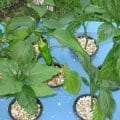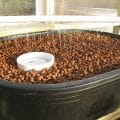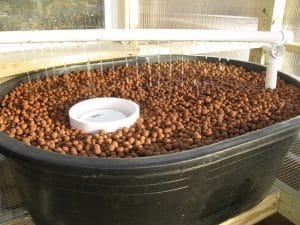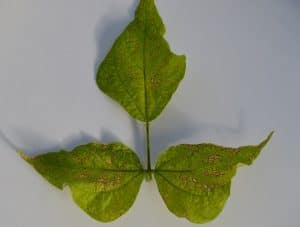The most important part of an aquaponic system is not the fish or the plants. The key component is actually single-celled microorganisms known commonly as nitrifying bacteria. These little organisms are essential to successful aquaponic gardening because they create the nitrogen cycle that turns fish waste into plant food. This conversion from waste into useful food is how aquaponics is able to offer its many benefits, including clean fish tanks and plants that do not require soil or expensive fertilizers for health growth. Bacteria often get a bad rap because many varieties are a source of infection, but aquaponics uses beneficial bacteria to make the whole system work harmoniously. Without this hardworking bacterium, both the fish and the plants in the system would suffer. In fact, these bacteria are so important that aquaponics is often referred to as bacteria farming.
Nitrifying Bacteria
Nitrifying bacteria got their name for the way they work within the nitrogen cycle. To understand the bacteria, you must first understand the cycle. The nitrogen cycle begins when fish produce waste in the form of ammonia. Fish food that does not get eaten also produces ammonia as it breaks down over time. This ammonia can be a real problem in a tank setting because higher levels can become toxic to the fish. Even in a traditional fish tank, ammonia removal has to occur, or the fish can suffer. This becomes a much bigger issue when you are trying to raise fish. More fish mean more ammonia, which can cause issues with slow growth, increased disease, and even death. Luckily, nitrifying bacteria can save the day. These microorganisms work within the system to convert waste material into usable, nutrient-rich food.

Beneficial Bacteria
The bacteria used in aquaponic farming are a far cry from the germs that make people and animals sick. Rather, it is a beneficial bacterium that helps the fish and the plants within the aquaponic system. The bacteria help the fish by removing toxic ammonia from their water supply. Too much ammonia can cause severe damage to the fish. Some side effects of ammonia build-up include tissue damage, damage to gills, poor oxygen conversion, slow or abnormal growth, increased risk of disease, and potentially death. The bacteria that convert and remove the ammonia from the water are essential for growing healthy fish. Without these bacteria, you would not be able to produce as many fish or grow them as large as you can when the nitrogen cycle is working properly.
The beneficial bacteria are also important for the hydroponic plants in the system. This is why aquaponics is often referred to as bacteria farming. The formula for successful plant growth is fairly simple. Plants need water, sunlight, and nutrients. In traditional farming methods, plants get their nutrients from the soil and from supplementation with fertilizers. In an aquaponics system, the need for soil and fertilizer is removed because the conversion of ammonia into nitrates provides the plants with all the nutrients they need. Because the bacteria are hard at work converting waste into nutritious food, the plants are able to grow quickly and remain healthy. This bacteria farming method is so effective that it has been growing in popularity all around the world, and is used in both homes and commercial gardening setups.
The bacteria in the system are so important that a healthy bacteria colony is the single best predictor of how effective an aquaponic system will be. When starting a new aquaponic system, it is important to give proper attention to establishing the bacteria colony. A biofilter with plenty of space for the bacteria to grow is a key component of your system. This filter needs to provide adequate space and should be shielded from the sunlight or grow lights because the bacteria prefer the dark. It is also important not to add too many fish to the system until the bacteria have established a healthy colony. The bacteria reproduce in response to an adequate food source, so their numbers will be small until enough ammonia is available for conversion. The same is true of the bacteria that convert nitrites into nitrates. As the colony becomes better established, more fish can be added to the system, and the cycle will continue to clean up waste and produce plant food.
As you can see, the bacteria in the aquaponic system are essential to its success. Without proper bacteria colonization, fish waste can build to toxic levels and plants will suffer without necessary nutrients. The bacteria are what make the system perform so effectively. With proper bacteria growth, the water in your aquaponic system can be cycled indefinitely, eliminating the need for tank cleanings, other types of filtration, and plant fertilizers. This is what makes aquaponics so cost-effective and efficient. Although they are microscopic, the bacteria are the biggest and most important part of your system. These beneficial bacteria keep the system working harmoniously, producing healthy fish and ensuring excellent plant growth.















I remember learning about the nitrogen cycle at school, however that’s knowledge I rarely apply to my daily life now, so the reminder of how the system works and it’s relation to aquaponics is very helpful. Definitely a good reminder of how everything is connected and how we need to keep a good balance.